
Sir Gawain and the Green Knight is a late 14th-century chivalric romance in Middle English alliterative verse. The author is unknown; the title was given centuries later. It is one of the best-known Arthurian stories, with its plot combining two types of folk motifs: the beheading game, and the exchange of winnings. Written in stanzas of alliterative verse, each of which ends in a rhyming bob and wheel, it draws on Welsh, Irish, and English stories, as well as the French chivalric tradition. It is an important example of a chivalric romance, which typically involves a hero who goes on a quest which tests his prowess. It remains popular in modern English renderings from J. R. R. Tolkien, Simon Armitage, and others, as well as through film and stage adaptations.

Lancelot du Lac, also written as Launcelot and other variants, is a character in some versions of Arthurian legend where he is typically depicted as King Arthur's close companion and one of the greatest Knights of the Round Table. In the French-inspired Arthurian chivalric romance tradition, Lancelot is an orphaned son of King Ban of the lost kingdom of Benoic, raised in a fairy realm by the Lady of the Lake. A hero of many battles, quests and tournaments, and famed as a nearly unrivalled swordsman and jouster, Lancelot becomes the lord of the castle Joyous Gard and personal champion of Arthur's wife, Queen Guinevere, despite suffering from frequent and sometimes prolonged fits of madness. But when his adulterous affair with Guinevere is discovered, it causes a civil war that, once exploited by Mordred, brings an end to Arthur's kingdom.
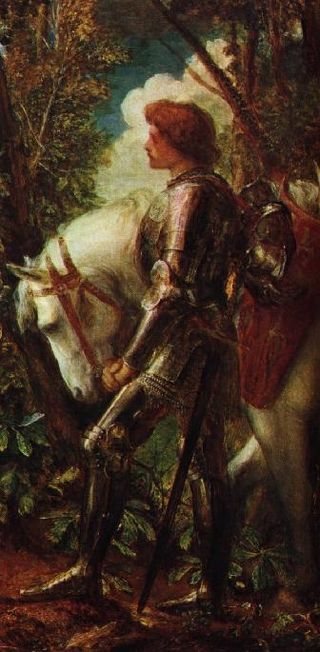
Galahad, sometimes referred to as Galeas or Galath, among other versions of his name, is a knight of King Arthur's Round Table and one of the three achievers of the Holy Grail in Arthurian legend. He is the illegitimate son of Sir Lancelot du Lac and Lady Elaine of Corbenic and is renowned for his gallantry and purity as the most perfect of all knights. Emerging quite late in the medieval Arthurian tradition, Sir Galahad first appears in the Lancelot–Grail cycle, and his story is taken up in later works, such as the Post-Vulgate Cycle, and Sir Thomas Malory's Le Morte d'Arthur. In Arthurian literature, he replaced Percival as the hero in the quest for the Holy Grail.

A Kid in King Arthur's Court is a 1995 adventure comedy fantasy film directed by Michael Gottlieb. It is loosely based on the Mark Twain 1889 novel A Connecticut Yankee in King Arthur's Court, previously filmed by Disney as Unidentified Flying Oddball in 1978. The film stars Thomas Ian Nicholas, Joss Ackland and Art Malik, and is notable for being one the first film roles of Daniel Craig and Kate Winslet.
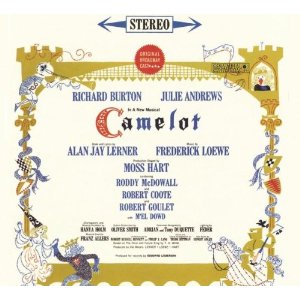
Camelot is a musical with music by Frederick Loewe and lyrics and a book by Alan Jay Lerner. It is based on the legend of King Arthur as adapted from the 1958 novel The Once and Future King by T. H. White.
Red Knight is a title borne by several characters in Arthurian legend.
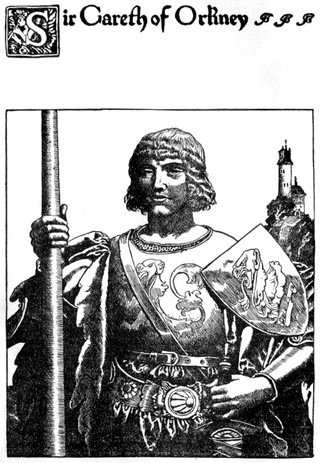
Gareth is a Knight of the Round Table in Arthurian legend. He is the youngest son of King Lot and Queen Morgause, King Arthur's half-sister, thus making him Arthur's nephew, as well as brother to Gawain, Agravain and Gaheris, and either a brother or half-brother of Mordred. Gareth is particularly notable in Le Morte d'Arthur, where one of its eight books is named after and largely dedicated to him, and in which he is also known by his nickname Beaumains.

Mark of Cornwall was a sixth-century King of Kernow (Cornwall), possibly identical with King Conomor. He is best known for his appearance in Arthurian legend as the uncle of Tristan and the husband of Iseult who engages with Tristan in a secret liaison, giving Mark the epithet "Cuckold King".
King Pellinore is the king of Listenoise or of "the Isles" in Arthurian legend. In the tradition from the Old French prose, he is associated with the Questing Beast and is the slayer of King Lot. His many children include the sons Aglovale, Lamorak, and Percival, and the daughter Dindrane.

Merlin is a 1998 two-part television miniseries starring Sam Neill as Merlin, recounting the wizard's life in the mythic history of Britain. Loosely adapted from the legendary tales of Camelot, the plot adds the antagonistic Queen Mab and expands Merlin's backstory before the birth of King Arthur.

Elaine of Astolat, also known as Elayne of Ascolat and other variants of the name, is a figure in Arthurian legend. She is a lady from the castle of Astolat who dies of her unrequited love for Sir Lancelot. Well-known versions of her story appear in Sir Thomas Malory's 1485 book Le Morte d'Arthur, Alfred, Lord Tennyson's mid-19th-century Idylls of the King, and Tennyson's poem "The Lady of Shalott". She should not be confused with Elaine of Corbenic, the mother of Galahad by Lancelot.

Knightriders is a 1981 American action drama film written and directed by George A. Romero and starring Ed Harris, Gary Lahti, Tom Savini, Amy Ingersoll, Patricia Tallman, and Christine Forrest. It was filmed entirely on location in the Pittsburgh metro area, including Fawn Township and Natrona during the summer of 1980.

Sword of the Valiant: The Legend of Sir Gawain and the Green Knight is a 1984 dramatic fantasy film directed by Stephen Weeks and starring Miles O'Keeffe, Trevor Howard, Lila Kedrova, Cyrielle Clair, Leigh Lawson, Peter Cushing, and Sean Connery. The film is loosely based on the poem Sir Gawain and the Green Knight, written in the late 14th century, but the narrative differs substantially. It was the second time Weeks had adapted the traditional tale into a film. His first effort was Gawain and the Green Knight (1973).

Knights of the Round Table is a 1953 British adventure historical film made by MGM in England and Ireland. Directed by Richard Thorpe and produced by Pandro S. Berman, it was the first film in CinemaScope made by the studio. The screenplay was by Talbot Jennings, Jan Lustig and Noel Langley from Sir Thomas Malory's Le Morte d'Arthur, first published in 1485 by William Caxton.

Adventures of Sir Galahad is the 41st serial released in 1949 by Columbia Pictures. Directed by Spencer Gordon Bennet, it stars George Reeves, Nelson Leigh, William Fawcett, Hugh Prosser, and Lois Hall. It was based on Arthurian legend, one of the very few serials of the time with a period setting that was not a western.

Siege of the Saxons is a 1963 British adventure film directed by Nathan H. Juran and released by Columbia Pictures. Starring Janette Scott and Ronald Lewis, the film is set in the time of King Arthur, but, as with many Arthurian themed films, the sets and style are from medieval England. The plot is also heavily influenced by Robin Hood.

Sir Percy of Scandia, also known as the original Black Knight, is a fictional character appearing in American comic books published by Marvel Comics. He was a medieval knight created by writer-editor Stan Lee and artist Joe Maneely.
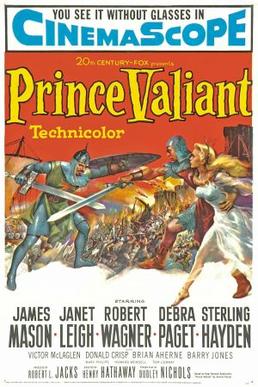
Prince Valiant is a 1954 American adventure film directed by Henry Hathaway and produced by Robert L. Jacks, in Technicolor and Cinemascope, produced and released by 20th Century-Fox. Based on the King Features syndicated newspaper comic strip of the same name by Hal Foster, the film stars James Mason, Janet Leigh, Robert Wagner, Debra Paget and Sterling Hayden.
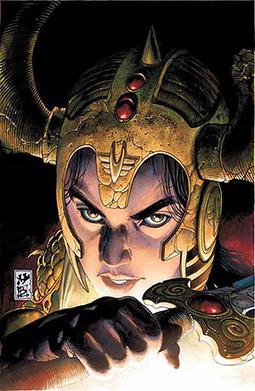
Shining Knight (Ystina) is a fictional character from DC Comics. He is the third character named Shining Knight and appears as a major character from Seven Soldiers. In The New 52 reboot, the character is reimagined as transgender.

















